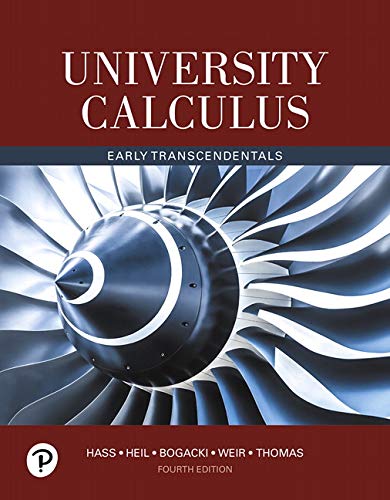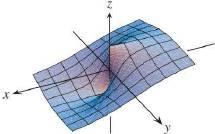
Concept explainers
By considering different paths of approach, show that the functions in Exercises 41−48 have no limit as (x, y) → (0, 0).
41.

Learn your wayIncludes step-by-step video

Chapter 13 Solutions
University Calculus: Early Transcendentals (4th Edition)
Additional Math Textbook Solutions
A First Course in Probability (10th Edition)
College Algebra with Modeling & Visualization (5th Edition)
Introductory Statistics
Pre-Algebra Student Edition
Calculus: Early Transcendentals (2nd Edition)
- 4. Suppose the demand for a certain item is given by D(p)=-2 p² - 4p+350, where p represents the price of the item in dollars. a) Find the rate of change of demand with respect to price. b) Find and interpret the rate of change of demand when the price is $11.arrow_forward√3-x, x≤3, 2. For f(x) = 1 find each of the following. x > 3, x-3' 1. f(-6) 2. f(3) 3. f(7) 3. Find the domain of each of the following functions.arrow_forward1. Using the definition of the derivative, find f'(x). Then find f'(2), f'(0) and f'(3) when the derivative exists. a) f(x)=5x²-6x-1arrow_forward
- 2. f(x)=√7-x 4. A manufacturer has a monthly fixed cost of $40,000 and a production cost of $8 for each unit produced. The product sells for $12 per unit. 1. What is the cost function? 2. What is the revenue function? 3. Compute the profit corresponding to 12,000 units. 5. A rectangular box is to have a square base and a volume of 20 ft3. The material for the base costs $0.30 per ft2, the material for the sides cost $0.10 per ft2, and the material for the top costs $0.20 per ft2. Letting x denote the length of one side of the base,arrow_forwardSolve using superposition principlearrow_forwardreview problems please help!arrow_forward
- 3. f(7) 3. Find the domain of each of the following functions. 1 1. f(x)=2-6x+8 2. f(x)=√√7-x 4. A manufacturer has a monthly fixed cost of $40,000 and a production cost of $8 for each unit produced. The product sells for $12 per unit.arrow_forward7. Evaluate the following limits and justify each step. (a) lim (3x²+2x+1) 1 x²+4x-12 (b) lim 1 2 x² - 2x t-√√3t+4 (c) lim t-0 4-t x²-6x+5 (d) lim (e) lim x 5 x-5 x→2 x²+2x+3 4u+1-3 (f) lim u➡2 u-2 1 (g) lim x-3 2 x 55 x - 7x4 +4 (h) lim xx 5x+2x-1 x+1 (i) lim x²-2x+5 - 7x8+4x7 +5xarrow_forward6. Given the following graph f(x). (-2,2) 2- -5 -3 -2 (-2,-1) -1 (0,1) -2- 1 (3,0) 2 3 4 5 (3,-1) א X Compute each of the following. (a) f(-2) (b) lim f(x) #129 (c) lim f(x) *→12+ (d) lim f(x) 811H (e) f(0) (f) lim f(x) 8011 (m) Is the function continuous at x = -2,0,3? Why or why not? (g) lim f(x) +0x (h) lim f(x) x 0 (i) f(3) (j) lim f(x) x-3- (k) lim f(x) x+3+ (1) lim f(x) #13arrow_forward
- 3. Compute the profit corresponding to 12,000 units. 5. A rectangular box is to have a square base and a volume of 20 ft3. The material for the base costs $0.30 per ft2, the material for the sides cost $0.10 per ft2, and the material for the top costs $0.20 per ft2. Letting a denote the length of one side of the base, find a function in the variable x giving the cost of constructing the box. 6. Given the following graph f(x).arrow_forward8. On what intervals, each function continuous? (a) f(x) = 3x11 + 4x²+1 3x²+5x-1 (b) g(x) = x²-4 X, x < 1, QTs the function f(x) continuous at = 1? Use the definition of continuity to justifyarrow_forwardreview problem please help!arrow_forward
 Calculus: Early TranscendentalsCalculusISBN:9781285741550Author:James StewartPublisher:Cengage Learning
Calculus: Early TranscendentalsCalculusISBN:9781285741550Author:James StewartPublisher:Cengage Learning Thomas' Calculus (14th Edition)CalculusISBN:9780134438986Author:Joel R. Hass, Christopher E. Heil, Maurice D. WeirPublisher:PEARSON
Thomas' Calculus (14th Edition)CalculusISBN:9780134438986Author:Joel R. Hass, Christopher E. Heil, Maurice D. WeirPublisher:PEARSON Calculus: Early Transcendentals (3rd Edition)CalculusISBN:9780134763644Author:William L. Briggs, Lyle Cochran, Bernard Gillett, Eric SchulzPublisher:PEARSON
Calculus: Early Transcendentals (3rd Edition)CalculusISBN:9780134763644Author:William L. Briggs, Lyle Cochran, Bernard Gillett, Eric SchulzPublisher:PEARSON Calculus: Early TranscendentalsCalculusISBN:9781319050740Author:Jon Rogawski, Colin Adams, Robert FranzosaPublisher:W. H. Freeman
Calculus: Early TranscendentalsCalculusISBN:9781319050740Author:Jon Rogawski, Colin Adams, Robert FranzosaPublisher:W. H. Freeman
 Calculus: Early Transcendental FunctionsCalculusISBN:9781337552516Author:Ron Larson, Bruce H. EdwardsPublisher:Cengage Learning
Calculus: Early Transcendental FunctionsCalculusISBN:9781337552516Author:Ron Larson, Bruce H. EdwardsPublisher:Cengage Learning





